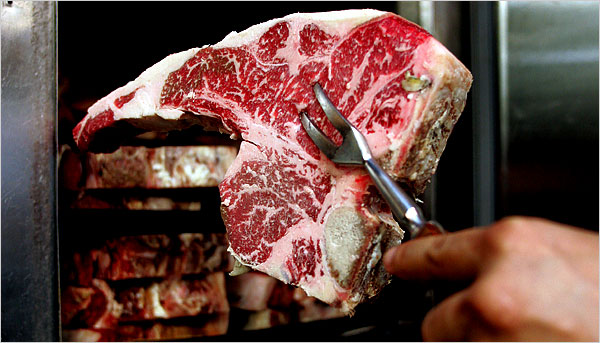Gaucho’s Argentinean Restaurant and everything you need to know about steak
Adelaide was the starting point of our Australian food odyssey and Gaucho’s was the first restaurant to grace the all-important food schedule that I put together on our yearly Australia trips.
This restaurant is a true Adelaide institution famous for it’s house-aged steaks and its chimmichurri sauce ”“ a tangy combination of olive oil, lemon, garlic, fennel, herbs and spices. We knew we were in for a treat walking past the open kitchen, spying a line of succulent steaks being lovingly tended to by a grill chef.
Now it was time to make a very difficult decision ”“ which steak to order?
Glance at a menu in any specialist steakhouse in Australia and you may be overwhelmed by the amount of choice on offer. Forget rare, medium or well done – do you want the grass or grain-fed, dry-aged for 17 or 45 days, Black Angus from Tasmania or full-blooded Wagyu from South Australia? Thankfully our waiter was very good at demystifying steak lingo and we ended up with some of the most flavoursome, melt-in-your-mouth steak we’ve eaten in a long time.
I’ll admit it. When eating at a steakhouse, I’ve almost been tempted to close my eyes and randomly point my finger at a piece of meat that lies somewhere around the steaks in my price range and then say ”˜medium-rare please.’ But listening to our in-the-know waiter inspired me to do some research on steak cuts, types of beef, and their rearing and preparation methods. So here’s what I learned:
Beefs cuts are different all around the world!
The Filet mignon/Tenderloin/Eye fillet is normally more expensive, lean, very tender but less flavoursome. When cut into smaller portions, the French call them the tournedos (smaller central portion of the tenderloin), chateaubriand (larger central portion of the tenderloin) and biftek (larger end of the tenderloin).
The Sirloin is cut from the rear back portion of the cow and has a little more fat and more flavour but can be less tender.
The Rib-eye/Entrecote/Scotch Fillet is from the rib section of the cow. It has the most fat and the most flavour of all cuts.
The T-bone and Porterhouse steaks come from the short loin (between the rib and sirloin section of the cow). The porterhouse is considered the more tender of the two as it contains the smaller end of the tenderloin.
Wagyu cows have the most marbling of any breed.
Wagyu beef is originally from Kobe, Japan and is known to be the highest quality in the world due to its great quantity of marbling. To increase marbling in the meat, Japanese farmers are known to restrict exercise, massage the cows, rub sake into their skin and feed them Japanese beer! All in the name of increasing appetites and softening their skin to ensure the amazing textural experience at the dinner table.
Marbling is what makes the meat melt-in-your-mouth.
Marbling is the term for the fine veins of fat spread throughout the meat itself. It is the reason for the unique flavour, texture and moisture of Wagyu beef.
Grass-fed cows are better for the health conscious.
Grain-fed cows are said to improve marbling in the meat. But the advantage for grass-fed cattle is the distinct flavour. Others also argue that grain isn’t a natural food for cattle and that you can taste the grain in the meat.
Grass-fed cattle are also generally lower in saturated fat, making them better for you to eat.
And what’s the deal with aged beef? Sounds suspiciously like a euphemism for “old meat” to me”¦
Beef isn’t necessarily at its eating best immediately after slaughter.
Dry aging beef will result in a loss of meat through water evaporation and surface mould (which is trimmed before serving) and is said to concentrate the flavour of the meat and improve its depth, richness and complexity.
An alternative is wet aging, where the meat is stored in large vacuum bags that seal the moisture in and keep the mould out. The meat you buy in the supermarket is typically wet-aged for 3-6 weeks.
Purists argue that wet aging doesn’t develop the flavour of the meat to the degree that dry aging does.
Gaucho’s Argentinean Restaurant
91 Gouger Street
Adelaide SA 5000
Australia
http://www.gauchos.com.au/
Share this
Like this





